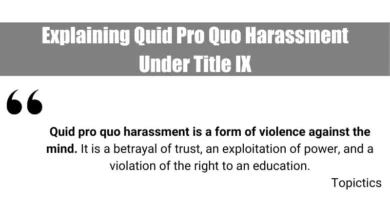What Employers Can Do to Prevent Quid Pro Quo Harassment
Employers can prevent quid pro quo harassment by implementing a comprehensive and proactive approach.
Key measures include establishing a robust anti-harassment policy that clearly defines prohibited behaviors and outlines consequences for violations. Regular training programs should be conducted to educate employees at all levels about recognizing, preventing, and reporting harassment.
Employers must provide multiple avenues for employees to report complaints confidentially without fearing retaliation. Ensuring timely and thorough investigations of all complaints, maintaining strict confidentiality, and protecting against retaliation are essential steps.
Regular monitoring and evaluation of harassment prevention efforts and strong leadership commitment to fostering a respectful workplace culture are also crucial.
Takeaways
| Key Points |
|---|
| A strong anti-harassment policy is the foundation for a workplace free from quid pro quo harassment, outlining zero tolerance, employee rights, responsibilities, and clear reporting procedures while providing explicit examples of prohibited conduct and consequences for violations. |
| Regular training programs are essential to educate employees on recognizing, reporting, and addressing harassment, using interactive methods tailored to different roles and delivered through various accessible formats at least annually. |
| Offering multiple avenues for confidential and victim-friendly reporting encourages employees to come forward, while timely, impartial, and thoroughly documented investigations conducted by trained professionals build trust and ensure fairness. |
| Maintaining confidentiality protects the privacy of all parties, with clear communication on policies and secure handling of sensitive information, balanced with limited transparency to uphold trust. |
| Leadership plays a pivotal role in fostering a respectful workplace by modeling appropriate behavior, enforcing policies, allocating resources, and encouraging an open culture of respect and accountability. |
Introduction
Quid pro quo harassment, a severe form of workplace misconduct, undermines employee morale, damages organizational reputation, and exposes employers to legal liabilities. Preventing this type of harassment requires employers to implement comprehensive strategies that address prevention and response.
Here is a detailed discussion of the steps employers should take to prevent quid pro quo harassment:
Establishing a Strong Anti-Harassment Policy
Elements of an Effective Anti-Harassment Policy
An anti-harassment policy forms the cornerstone of a workplace free from quid pro quo harassment. Such a policy should articulate a zero-tolerance stance against all forms of harassment, providing a clear framework for acceptable behavior.
It should outline the company’s commitment to preventing harassment, describe the rights and responsibilities of employees, and detail the procedures for reporting and addressing complaints.
Clear Definitions of Prohibited Conduct
Clarity in defining prohibited conduct is crucial. The policy should specify what constitutes quid pro quo harassment—situations where submission to or rejection of unwelcome sexual advances or requests for sexual favors is used as a basis for employment decisions.
This includes promotions, job assignments, and other workplace benefits. Clear examples help employees understand what behaviors are unacceptable.
Examples of Quid Pro Quo Harassment
Providing concrete examples in the policy helps illustrate the behaviors that will not be tolerated. Examples include:
- A supervisor requesting sexual favors in exchange for a promotion.
- A manager threatening to fire an employee for rejecting sexual advances.
- An employer alters work conditions or performance evaluations based on an employee’s response to sexual requests.
Consequences for Violations
The policy must clearly state the consequences for violating anti-harassment rules. This includes disciplinary actions such as reprimands, demotions, suspensions, or termination of employment. Clear consequences demonstrate the company’s commitment to maintaining a harassment-free workplace and deterring potential violators.
Regular Training and Education
Importance of Training Programs
Training programs are vital for educating employees about harassment and reinforcing the company’s commitment to preventing it. Effective training helps employees recognize harassment, understand their rights, and know the procedures for reporting incidents.
Regular training ensures all employees, including new hires and long-term staff, know their roles in maintaining a respectful workplace.
Key Components of Harassment Prevention Training
Harassment prevention training should cover:
- Definitions and examples of quid pro quo harassment.
- Employees’ rights and responsibilities.
- The process for reporting complaints.
- The role of managers and supervisors in preventing and addressing harassment.
- Strategies for bystander intervention.
Interactive training sessions with role-playing scenarios and discussions can effectively engage employees and reinforce key concepts.
Frequency and Methods of Training Delivery
Training should be conducted regularly, at least annually, to keep the information fresh and at the top of mind. Various methods, including in-person workshops, online courses, and webinars, can be used.
Using multiple formats ensures all employees can access the training, regardless of location or schedule.
Tailoring Training for Different Levels of Employees
Training should be tailored to meet the specific needs of different employee groups. For example, managers and supervisors should receive additional training on handling complaints and conducting investigations, while general employees must understand their rights and the reporting process.
Tailoring the training ensures that it is relevant and effective for all participants.

Creating Multiple Avenues for Reporting Complaints
Importance of Providing Multiple Reporting Channels
Offering multiple avenues for reporting harassment is crucial in encouraging employees to come forward. When employees have options, they are more likely to feel comfortable reporting incidents, especially if they fear retaliation or feel uncomfortable speaking directly to their supervisor.
Design of a Victim-Friendly Complaint Process
A victim-friendly complaint process should be straightforward and accessible. It should allow for confidential reporting and assure employees that their complaints will be taken seriously.
Providing anonymous reporting options, such as hotlines or online forms, can encourage employees to report incidents without fear of exposure.
Ensuring Accessibility and Confidentiality in Reporting
Accessibility and confidentiality are key components of an effective reporting system. Employees should be able to report harassment through various means, including email, phone, and in-person meetings.
Ensuring that all reports are handled confidentially helps protect the privacy of the complainant and the accused, maintaining trust in the reporting process.

Ensuring Timely and Thorough Investigations
Steps for Conducting Effective Investigations
Investigations should be initiated promptly upon receiving a complaint. The process involves several steps:
- Initial Assessment: Determine the nature and severity of the complaint.
- Investigation Plan: Outline the steps to gather evidence, including interviews and document reviews.
- Conducting Interviews: Speak with the complainant, the accused, and witnesses to gather comprehensive information.
- Evidence Collection: Gather and review relevant documents, emails, and other materials.
- Analysis: Assess the credibility of the information collected and determine whether harassment occurred.
Role of Trained Investigators
Investigators should be trained professionals who understand the nuances of handling harassment complaints. Their role includes ensuring the investigation is impartial, thorough, and fair to all parties involved.
Trained investigators can navigate the complexities of harassment cases effectively, ensuring a just outcome.
Importance of Impartiality and Fairness
Impartiality and fairness are critical in the investigation process. Employers should avoid making premature judgments and ensure that both the complainant and the accused have an opportunity to present their side of the story. An unbiased approach builds trust in the investigation process and helps maintain a respectful workplace environment.
Documenting Findings and Actions Taken
Proper documentation is essential throughout the investigation process. Detailed records of the complaint, the investigation steps, findings, and actions should be maintained. Documentation ensures transparency and can be critical in defending against potential legal claims.
Maintaining Confidentiality
Importance of Protecting the Privacy of All Parties Involved
Maintaining confidentiality during the handling of harassment complaints is paramount. It helps protect the privacy of the complainant, the accused, and any witnesses involved. Ensuring confidentiality encourages employees to come forward without fear of public exposure or professional repercussions.
Confidentiality not only safeguards the dignity and privacy of individuals but also upholds the integrity of the investigation process. When employees trust that their complaints will be handled discreetly, they are more likely to report misconduct, fostering a safer workplace environment.
Best Practices for Maintaining Confidentiality
To maintain confidentiality effectively, employers should adopt several best practices:
- Limited Disclosure: Share information only with those who need to know to address the complaint. This typically includes HR personnel, investigators, and sometimes legal advisors.
- Secure Documentation: Keep all documentation related to harassment complaints in secure, restricted-access files. Digital records should be password-protected, and physical records should be stored in locked cabinets.
- Training on Confidentiality: Provide training for HR staff and managers on confidentiality and the correct handling of sensitive information.
- Clear Communication: Inform all parties involved in the complaint process about the confidentiality policy and the importance of maintaining discretion.
Balancing Transparency with Confidentiality Needs
While maintaining confidentiality is crucial, there is also a need for transparency in the investigation process to some extent. Employers must balance these two requirements carefully.
Transparency about the process helps build trust in the system, showing that complaints are taken seriously and handled fairly. However, details about the complaint, identities of those involved, and specifics of the investigation should remain confidential. Employers can achieve this balance by:
- Providing general updates on the status of the investigation without revealing specific details.
- Ensuring that all communications are professional and do not disclose sensitive information.

Protecting Against Retaliation
Defining and Identifying Retaliation
Retaliation involves any adverse action against an employee for participating in a protected activity, such as reporting harassment or assisting in an investigation. It can take many forms, including demotions, unjustified negative evaluations, job termination, and other punitive actions.
Recognizing and preventing retaliation is critical to fostering an environment where employees feel safe reporting misconduct.
Implementing Anti-Retaliation Measures
Employers can implement several measures to protect employees from retaliation:
- Clear Anti-Retaliation Policy: Establish and communicate a strict anti-retaliation policy that defines retaliation and outlines consequences for engaging in it.
- Training: Provide regular training for all employees, especially supervisors and managers, on what constitutes retaliation and how to avoid it.
- Monitoring: Keep track of the treatment of employees who have filed complaints or participated in investigations to detect any signs of retaliation.
Monitoring and Addressing Retaliatory Behavior
Regularly monitoring the workplace environment is essential to identify and address retaliatory behavior promptly. Employers should:
- Conduct follow-up meetings with complainants to check for any signs of retaliation.
- Encourage employees to report any suspected retaliation immediately.
- Take swift and decisive action against retaliatory behavior, demonstrating a zero-tolerance approach.
Regular Monitoring and Evaluation
Importance of Ongoing Assessment of Harassment Prevention Efforts
Continuous monitoring and evaluation of harassment prevention efforts are crucial for maintaining an effective program. Regular assessments help identify areas for improvement and ensure that policies and procedures remain relevant and effective in addressing workplace harassment.
Methods for Evaluating Policy Effectiveness
Employers can use various methods to evaluate the effectiveness of their harassment prevention policies:
- Employee Surveys: Conduct anonymous surveys to gather employee feedback about the workplace environment and the effectiveness of harassment prevention measures.
- Review of Complaints: Analyze harassment complaints to identify patterns or recurring issues that may indicate areas needing improvement.
- Training Evaluations: Assess the impact of training programs through pre- and post-training surveys and evaluations.
Making Improvements Based on Feedback and Incidents
Based on the feedback and data collected, employers should make necessary adjustments to their policies and procedures. This may include updating training materials, revising the anti-harassment policy, and improving the complaint-handling process.
Regularly reviewing and refining these measures helps ensure the workplace remains safe and respectful for all employees.

Leadership Commitment
Role of Leadership in Preventing Harassment
Leadership plays a vital role in preventing harassment in the workplace. Leaders set the tone for organizational culture and behavior. Their commitment to a harassment-free workplace is essential in fostering an environment of respect and accountability.
When leaders actively support and enforce anti-harassment policies, all employees know harassment will not be tolerated.
Demonstrating Commitment Through Actions and Policies
Leaders can demonstrate their commitment to preventing harassment by:
- Leading by Example: Model respectful and professional behavior at all times.
- Supporting Policies: Ensure that anti-harassment policies are comprehensive and enforced consistently.
- Allocating Resources: Provide adequate resources for training, investigating, and enforcing harassment policies.
Encouraging a Culture of Respect and Zero Tolerance for Harassment
Building a culture of respect requires ongoing effort from leadership. Employers should promote open communication, encourage employees to speak up against misconduct, and recognize positive behavior contributing to a respectful workplace.
Regularly reinforcing the importance of a harassment-free environment helps embed these values into the organizational culture.
Conclusion
Preventing quid pro quo harassment is a critical responsibility for employers.
By establishing strong anti-harassment policies, providing regular training, creating accessible reporting mechanisms, conducting thorough investigations, maintaining confidentiality, protecting against retaliation, and continuously monitoring and evaluating their efforts, employers can create a safe and respectful workplace.
Leadership commitment to these principles is essential in fostering a culture where harassment is not tolerated and every employee feels valued and secure.
FAQ
How does comprehensive Sexual Harassment Policy Implementation prevent quid pro quo harassment?
A robust sexual harassment policy implementation serves as the foundation for a respectful workplace. Employers set clear behavioral expectations by clearly defining quid pro quo behavior, outlining unacceptable conduct, and specifying the consequences for violations. Such policies are disseminated through employee handbooks, posted notices, and digital platforms to ensure every staff member understands their rights and responsibilities. Regular training and updates further reinforce the policy, fostering an environment where employees feel informed and protected.
What role do Employee Training Programs play in mitigating quid pro quo harassment?
Employee training programs are central to preventing harassment by educating staff on what constitutes quid pro quo behavior, how to recognize warning signs, and the proper channels for reporting concerns. These programs—often delivered through interactive workshops, e-learning modules, and scenario-based exercises—help demystify legal and ethical boundaries, encourage bystander intervention, and empower employees to uphold a respectful workplace. Consistent training reinforces a culture of zero tolerance toward harassment and ensures that both new and existing employees are continually aware of their responsibilities.
How do Clear Reporting Mechanisms reduce incidents of quid pro quo harassment?
Clear reporting mechanisms create accessible, confidential channels for employees to voice concerns without fear of retaliation. Employers ensure that every incident can be promptly documented and addressed by establishing multiple avenues—such as dedicated hotlines, online reporting portals, and direct lines to HR. This transparency not only aids in early detection but also builds trust within the organization, ensuring that employees know their concerns will be taken seriously and handled with discretion and fairness.
What impact do Managerial Accountability Systems have on preventing quid pro quo harassment?
Managerial accountability systems hold leaders directly responsible for upholding anti-harassment standards within their teams. These systems involve clear performance metrics tied to maintaining a respectful work environment, regular performance reviews that include feedback on handling harassment complaints, and structured oversight to ensure compliance with established policies. When managers are held accountable, they are more likely to act decisively in preventing and addressing inappropriate behavior, setting a tone of responsibility from the top down.
How effective are Anonymous Complaint Platforms in preventing quid pro quo harassment?
Anonymous complaint platforms offer employees a safe space to report incidents without exposing their identities, thereby reducing fears of retaliation. Such platforms are typically hosted through secure, third-party systems or dedicated internal software that guarantees confidentiality. This anonymity encourages more employees to come forward with concerns and helps employers gather comprehensive data on potential issues, enabling them to intervene proactively and reinforce a culture of trust and accountability.
What are the benefits of Risk Assessment Procedures in preventing quid pro quo harassment?
Risk assessment procedures allow organizations to identify vulnerabilities and high-risk areas where quid pro quo harassment might occur. Employers can pinpoint specific challenges and implement targeted interventions by systematically evaluating workplace practices, communication patterns, and employee feedback. These assessments often lead to tailored training programs, policy revisions, and enhanced monitoring systems that collectively reduce the likelihood of harassment and promote a proactive rather than reactive approach to prevention.
How do Regular Policy Reviews contribute to preventing quid pro quo harassment?
Regular policy reviews ensure that anti-harassment measures remain current, effective, and aligned with evolving legal standards and social expectations. Employers can address any emerging issues or loopholes by routinely examining and updating policies based on feedback, incident reports, and best practices. This process reinforces a dynamic approach to workplace safety and demonstrates an ongoing commitment to preventing quid pro quo harassment by adapting to new challenges and insights.
How does Zero Tolerance Enforcement help in the prevention of quid pro quo harassment?
Zero tolerance enforcement means that any instance of quid pro quo harassment is met with swift, consistent, and firm disciplinary action. This uncompromising approach sends a clear message throughout the organization that harassment will not be tolerated under any circumstances. By applying uniform consequences regardless of an employee’s position, employers create a deterrent effect and reinforce the principle that a respectful workplace is a non-negotiable standard for all.
What role do Proactive Communication Strategies play in preventing quid pro quo harassment?
Proactive communication strategies involve regularly sharing information about harassment policies, training opportunities, and available reporting channels with employees. Through regular newsletters, town hall meetings, and internal memos, these strategies keep the issue of harassment prevention at the forefront of organizational culture. Open communication educates employees about what constitutes quid pro quo behavior and reinforces that leadership is actively engaged in creating a safe, inclusive environment.
Why are Bias-Free Investigative Processes crucial in addressing quid pro quo harassment?
Bias-free investigative processes ensure that all allegations of quid pro quo harassment are examined objectively and thoroughly. By employing standardized protocols and impartial investigators—often supported by external experts—employers can build a fair and transparent process. Such investigations maintain the credibility of the reporting system, provide equitable treatment for all parties involved, and ultimately help restore trust among employees by ensuring that decisions are based on facts rather than personal biases.
How do Internal Auditing Practices help identify and prevent quid pro quo harassment?
Internal auditing practices involve periodic reviews of policies, procedures, and workplace interactions to gauge the effectiveness of anti-harassment measures. Through surveys, interviews, and data analysis, audits can uncover patterns or systemic issues that might contribute to an environment where quid pro quo harassment could occur. This comprehensive review process enables organizations to refine training programs, adjust policies, and take corrective actions before problems escalate, ensuring continuous improvement in workplace safety.
What benefits do Third-Party Mediation Services offer in preventing quid pro quo harassment?
Engaging third-party mediation services provides an objective and confidential means of resolving harassment complaints. These services bring in external experts who can assess situations without internal bias, facilitate constructive dialogue between parties, and offer recommendations for resolution. By leveraging an impartial mediator, employers can address issues more transparently and efficiently, restoring confidence in the reporting process and reinforcing a culture prioritizing fairness and respect.
How does Workplace Culture Optimization contribute to preventing quid pro quo harassment?
Workplace culture optimization deliberately shapes an environment where respect, inclusion, and professionalism are ingrained values. This can be achieved through leadership initiatives, diversity and inclusion programs, and regular engagement activities that celebrate positive behavior. By fostering a culture that inherently discourages any form of harassment, organizations create a proactive defense against quid pro quo incidents and empower employees to support one another in maintaining a safe work environment.
What Legal Compliance Strategies are effective in preventing quid pro quo harassment?
Effective legal compliance strategies require organizations to align their policies and practices with the latest federal, state, and local regulations concerning workplace harassment. This involves regular consultation with legal experts, integrating statutory requirements into training programs, and ensuring that all procedural steps meet or exceed legal standards. By maintaining rigorous legal compliance, employers not only protect themselves from liability but also create a framework that upholds the rights of employees and promotes a consistent, lawful approach to preventing harassment.
How do Data-Driven Monitoring Systems enhance the prevention of quid pro quo harassment?
Data-driven monitoring systems utilize advanced analytics to track incidents, training participation, and employee feedback over time. These systems enable employers to identify trends, measure the effectiveness of current policies, and swiftly detect areas of concern before they escalate. By relying on quantitative data, organizations can make informed decisions about where to focus their resources and how to adjust preventive strategies, ensuring that measures remain both effective and responsive to the evolving workplace landscape.










Comments are closed.